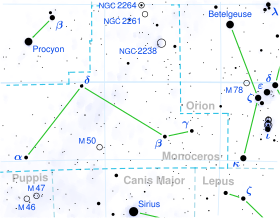Delta Monocerotis
Appearance
| Observation data Epoch J2000 Equinox J2000 | |
|---|---|
| Constellation | Monoceros |
| Right ascension | 07h 11m 51.860s[1] |
| Declination | 0° 29′ 33.96″[1] |
| Apparent magnitude (V) | 4.15[2] |
| Characteristics | |
| Spectral type | A2V[3] |
| U−B color index | +0.04[4] |
| B−V color index | +0.00[4] |
| Astrometry | |
| Radial velocity (Rv) | +15.00[5] km/s |
| Proper motion (μ) | RA: +0.79[6] mas/yr Dec.: +4.52[6] mas/yr |
| Parallax (π) | 8.49 ± 0.17 mas[6] |
| Distance | 384 ± 8 ly (118 ± 2 pc) |
| Absolute magnitude (MV) | -1.20[2] |
| Details | |
| Mass | 3.48[7] M☉ |
| Luminosity | 350[7] L☉ |
| Temperature | 9,462[7] K |
| Metallicity [Fe/H] | 0.00[8] dex |
| Rotational velocity (v sin i) | 154[7] km/s |
| Other designations | |
| Database references | |
| SIMBAD | data |
Delta Monocerotis (δ Mon) is a class A2V[3] (white main-sequence) star in the constellation Monoceros. Its apparent magnitude is 4.15[2] and it is approximately 384 light years away based on parallax.[6]
It has one reported companion, B, at separation 32.0" and magnitude 13.0.[9]
References
- ^ a b Høg, E.; Fabricius, C.; Makarov, V. V.; Urban, S.; Corbin, T.; Wycoff, G.; Bastian, U.; Schwekendiek, P.; Wicenec, A. (2000). "The Tycho-2 catalogue of the 2.5 million brightest stars". Astronomy and Astrophysics. 355: L27. Bibcode:2000A&A...355L..27H.
- ^ a b c Anderson, E.; Francis, Ch. (2012). "XHIP: An extended hipparcos compilation". Astronomy Letters. 38 (5): 331. arXiv:1108.4971. Bibcode:2012AstL...38..331A. doi:10.1134/S1063773712050015. Vizier catalog entry
- ^ a b Hoffleit, D.; Warren, W. H. (1995). "VizieR Online Data Catalog: Bright Star Catalogue, 5th Revised Ed. (Hoffleit+, 1991)". VizieR On-line Data Catalog: V/50. Originally published in: 1964BS....C......0H. 5050. Bibcode:1995yCat.5050....0H.
- ^ a b Mallama, A. (2014). "Sloan Magnitudes for the Brightest Stars". The Journal of the American Association of Variable Star Observers. 42: 443. Bibcode:2014JAVSO..42..443M.Vizier catalog entry
- ^ Gontcharov, G. A. (2006). "Pulkovo Compilation of Radial Velocities for 35 495 Hipparcos stars in a common system". Astronomy Letters. 32 (11): 759. arXiv:1606.08053. Bibcode:2006AstL...32..759G. doi:10.1134/S1063773706110065.
- ^ a b c d Van Leeuwen, F. (2007). "Validation of the new Hipparcos reduction". Astronomy and Astrophysics. 474 (2): 653. arXiv:0708.1752. Bibcode:2007A&A...474..653V. doi:10.1051/0004-6361:20078357. Vizier catalog entry
- ^ a b c d Zorec, J.; Royer, F. (2012). "Rotational velocities of A-type stars". Astronomy & Astrophysics. 537: A120. arXiv:1201.2052. Bibcode:2012A&A...537A.120Z. doi:10.1051/0004-6361/201117691. Vizier catalog entry
- ^ Gontcharov, G. A. (2012). "Dependence of kinematics on the age of stars in the solar neighborhood". Astronomy Letters. 38 (12): 771. arXiv:1606.08814. Bibcode:2012AstL...38..771G. doi:10.1134/S1063773712120031. Vizier catalog entry
- ^ Dommanget, J.; Nys, O. (2002). "VizieR Online Data Catalog: CCDM (Catalog of Components of Double & Multiple stars) (Dommanget+ 2002)". VizieR On-line Data Catalog: I/274. Originally published in: Observations et Travaux 54. 1274. Bibcode:2002yCat.1274....0D. Vizier catalog entry

